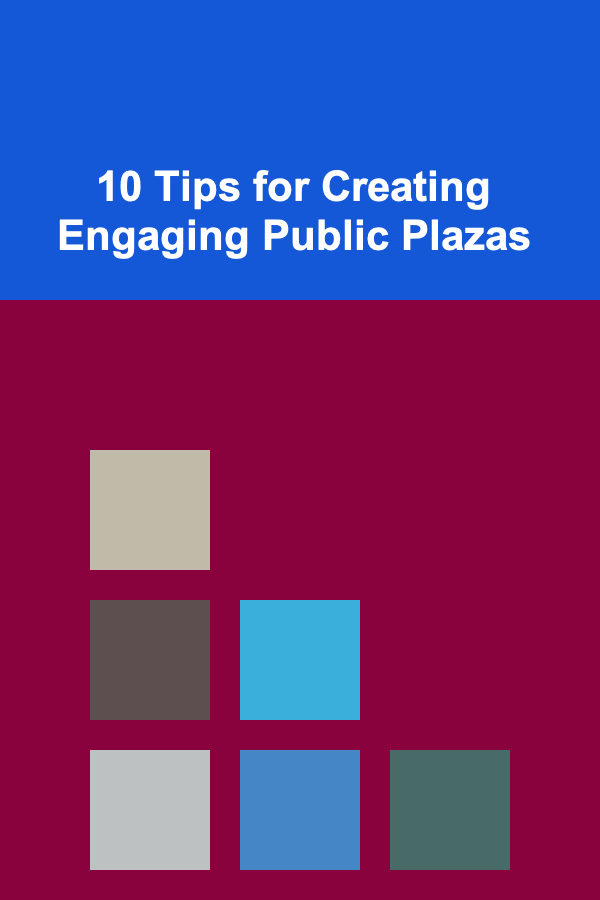
10 Tips for Creating Engaging Public Plazas
ebook include PDF & Audio bundle (Micro Guide)
$12.99$8.99
Limited Time Offer! Order within the next:

Public plazas have long been a crucial element of urban design, serving as spaces for social interaction, cultural exchange, and relaxation. Well-designed public plazas are more than just open areas; they are places where communities gather, interact, and experience a sense of belonging. A well-constructed plaza can revitalize a neighborhood, promote local culture, and enhance the quality of life for its inhabitants. Whether it's a historic city square or a newly designed urban park, creating a plaza that draws people in requires a thoughtful approach.
Creating an engaging public plaza is a multifaceted task that involves a combination of design, accessibility, functionality, and aesthetics. It requires considering the needs of diverse users, the surrounding environment, and the broader context of the city. In this article, we will explore ten key tips for designing public plazas that are not only functional but also lively, inviting, and engaging.
Prioritize Accessibility
One of the most fundamental principles of a public plaza is ensuring it is accessible to everyone. Accessibility goes beyond making sure that the space is physically reachable; it also includes accommodating people with different abilities, ages, and backgrounds. A truly inclusive plaza ensures that all individuals can enjoy the space without encountering obstacles.
Designing for Accessibility
- Universal Design: Use principles of universal design to create spaces that can be used by people of all abilities. This includes wide walkways, ramps, and clear signage.
- Seating and Rest Areas: Provide seating options at different heights and styles to accommodate various preferences and abilities. Some may prefer sitting on benches, while others may opt for soft seating or even lounging spaces.
- Smooth Surfaces: Ensure the ground is level and made of materials that are easy to navigate for people with mobility challenges, such as wheelchairs or strollers.
- Visual Accessibility: Ensure there's clear contrast between pathways, seating areas, and surrounding features to help those with visual impairments navigate the plaza safely.
Transportation Access
- Public Transit: Design the plaza in proximity to public transit hubs or stops. Ensure easy access for people arriving by buses, trains, or trams.
- Bike Accessibility: Incorporate bike racks and bike-friendly paths to encourage cycling as a mode of transport.
Create a Sense of Place
A successful public plaza should feel like an integral part of the city, contributing to the identity of the surrounding neighborhood. A sense of place is established through design elements that reflect the local culture, history, and environment. When people connect emotionally to a plaza, they are more likely to return and spend time there.
Incorporate Local Culture
- Public Art: Install sculptures, murals, or interactive art pieces that reflect the local community's culture and heritage. Art can be a powerful tool for storytelling and creating a connection to place.
- Historical References: If the plaza is situated in a historically significant area, consider incorporating design elements or informational plaques that reflect the history of the place. This could include restoring or highlighting old architectural features, or referencing local events and stories.
- Local Materials: Use materials sourced from the local area to create a stronger sense of belonging. For example, natural stone, wood, or metal that mirrors the surrounding landscape or architectural style can make the plaza feel more connected to its environment.
Encourage Social Interaction
A plaza should be a place where people feel comfortable gathering, interacting, and engaging with one another. To create a sense of community, it's essential to design spaces that encourage social interaction.
Flexible Spaces for Gathering
- Seating Arrangements: Offer a variety of seating options, from intimate benches to large communal tables. This provides spaces for both small and large groups, accommodating people who want to socialize or simply relax alone.
- Open Spaces: Include open areas that can host temporary events like markets, festivals, or performances. These flexible spaces can activate the plaza and draw people in.
- Public Restrooms: Access to clean and well-maintained public restrooms is essential for making a plaza a welcoming space for all visitors. Make sure they are easily accessible and strategically placed within the plaza.
Playful Elements
- Interactive Features: Incorporate elements like fountains, water features, or even tactile installations that invite people to engage physically. These features can make a plaza more dynamic and enjoyable for both children and adults.
- Informal Spaces: Create spaces where people can gather informally, such as grassy knolls, shaded areas, or café-style seating. These types of spaces naturally encourage people to relax, converse, and interact.
Incorporate Green Spaces and Landscaping
Urban environments can often feel concrete-heavy and disconnected from nature. Incorporating green spaces into a public plaza can help soften the hard edges of the built environment and make the space more inviting and comfortable.
Use Plantings Strategically
- Tree Canopies: Planting trees around the plaza provides shade, which can make the space more comfortable during hot weather. It also contributes to air quality and creates a calming atmosphere.
- Gardens and Flower Beds: Planting vibrant flowers or creating small garden spaces can add visual interest and provide sensory experiences such as color, texture, and fragrance.
- Green Walls: If space allows, vertical gardens or green walls can provide greenery in areas where traditional landscaping is difficult.
Environmental Sustainability
- Native Plants: Use native plants that are well-suited to the local climate and environment. Native plants are easier to maintain and provide important habitat for local wildlife.
- Sustainable Landscaping Practices: Consider using rain gardens or permeable paving to manage stormwater runoff, reducing the environmental impact of the plaza.
Ensure Safety and Comfort
Safety and comfort are paramount in any public space. People need to feel secure and at ease in order to enjoy a plaza, and thoughtful design can play a major role in achieving this.
Lighting and Visibility
- Well-Illuminated Areas: Ensure the plaza is well-lit, particularly in areas where people are likely to gather after dark. Lighting should be bright enough for safety but also warm and welcoming to create an inviting atmosphere.
- Visible Sightlines: Avoid obstructing sightlines with large structures or dense plantings that could make people feel unsafe. Open spaces and clear sightlines to the surrounding streets or other areas increase the feeling of safety.
Comfortable Microclimates
- Shade and Shelter: In hot climates, shade is essential. Consider placing seating under trees, pergolas, or fabric shade structures to protect people from the sun. In cooler climates, windbreaks or sheltered spots can provide a sense of comfort.
- Comfortable Surfaces: Pay attention to the comfort of walking surfaces. While hard surfaces like concrete may be necessary for durability, softer surfaces like grass or rubber tiles may offer relief and comfort for people resting.
Provide Entertainment and Events
Plazas that are constantly activated by events and activities are more likely to be successful in engaging the community. Thoughtfully programmed events can transform a quiet, empty plaza into a vibrant, exciting space.
Performance Spaces
- Amphitheaters or Stages: A small performance space or outdoor stage can be used for concerts, theater performances, or community gatherings. These events add an element of entertainment and bring diverse groups of people together.
- Pop-up Events: Encourage the use of temporary installations such as art exhibitions, food trucks, or outdoor movie screenings. These spontaneous events can create excitement and attract a wide variety of people.
Community Programming
- Fitness Classes or Markets: Offering community-driven activities like yoga, tai chi, or pop-up farmers' markets can attract different demographics and create a sense of connection.
- Cultural Events: Host seasonal events that celebrate local culture, traditions, and festivities, bringing the community together and enhancing the plaza's relevance.
Design for Climate and Weather Considerations
The climate of the region plays a critical role in how people use and experience public plazas. Design elements should be responsive to local weather patterns to ensure comfort throughout the year.
Adaptability to Weather
- Sun Protection: In hot climates, ensuring ample shade with trees, pergolas, or shade structures is essential to keep the plaza comfortable during the day.
- Winter Design: In colder climates, design for winter usability by including sheltered areas or heating elements. Plazas in winter cities often include features like heated benches or areas where people can warm up.
- Rain and Wind Protection: In areas prone to rain or wind, consider incorporating windbreaks, waterproof materials, and sheltered spaces to make the plaza usable in all weather conditions.
Foster a Sense of Ownership
People are more likely to take care of and frequent a public space when they feel a sense of ownership. Encouraging community involvement in the design, maintenance, and programming of a plaza is a key strategy for ensuring its long-term success.
Community Input
- Participatory Design: Engage local residents in the design process by hosting community meetings, surveys, or workshops. This gives people a stake in the project and ensures the plaza reflects the needs and desires of the community.
- Volunteer Maintenance: Create opportunities for local volunteers to help maintain the space. This could include gardening, organizing events, or helping with day-to-day upkeep.
Create a Sustainable and Future-Proof Design
Designing with sustainability in mind ensures that the plaza remains functional and valuable for future generations. Consider environmental, social, and economic sustainability when planning the space.
Energy Efficiency
- Solar Power: Use solar panels to power lighting or water features, making the plaza more energy-efficient and sustainable.
- Sustainable Materials: Select durable, sustainable materials that minimize environmental impact and reduce maintenance costs in the long run.
Long-Term Maintenance
- Low-Maintenance Design: Choose materials and design elements that are easy to maintain and clean. A well-maintained plaza will continue to serve its purpose over time without requiring frequent costly repairs.
Integrate Technology Thoughtfully
Technology can play an important role in enhancing the plaza experience, but it should be integrated thoughtfully and in a way that adds value to the space.
Interactive Features
- Wi-Fi and Charging Stations: Offering free Wi-Fi or charging stations can encourage people to stay longer and use the space as a hub for remote work or socializing.
- Digital Information Boards: Digital screens can display community events, local news, or real-time updates about the plaza, making the space more informative and engaging.
Smart Technology
- Lighting Control: Use smart lighting systems that can be programmed to adjust based on time of day or specific events.
- Waste Management: Consider integrating smart waste bins that can alert maintenance teams when they're full, improving cleanliness and efficiency.
Conclusion
Creating an engaging public plaza is not just about designing a functional space; it's about creating an experience that encourages people to gather, relax, and interact. By focusing on accessibility, community involvement, sustainability, and thoughtful design, urban planners can create public plazas that become the heartbeat of a neighborhood. These spaces not only provide essential services but also foster a sense of community and belonging, ensuring that people will want to return time and time again. With careful planning and attention to detail, any city can create a plaza that is engaging, vibrant, and deeply connected to its people.
Reading More From Our Other Websites
- [Personal Care Tips 101] How to Use a Face Mask to Even Out Skin Tone
- [Home Soundproofing 101] How to Soundproof Your Home's Exterior for Less Street Noise
- [Ziplining Tip 101] Storytelling at Speed: How to Structure a Ziplining Episode for Maximum Impact
- [Organization Tip 101] How to Choose the Perfect Style and Finish for Your Cabinet Refacing Kit
- [Personal Care Tips 101] How to Choose the Right Blush for Your Skin Tone
- [Reading Habit Tip 101] Simple Tricks to Turn Reading into a Daily Habit
- [Personal Finance Management 101] How to Budget for an Irregular Income
- [Home Space Saving 101] How to Maximize Living Room Space with Corner Shelves
- [Organization Tip 101] How to Set Up a Scrap Fabric Storage System
- [Home Pet Care 101] How to Create a Pet Wellness Station at Home

How to Create a Quiet Study Room with Soundproofing Techniques
Read More
How to Create a Study Group Using Online Platforms
Read More
How to Sell Your Old Vinyl Records on eBay: A Comprehensive Actionable Guide
Read More
How to Soundproof Your Windows Using Soundproof Curtains
Read More
How to Use Efficient Meal Prepping Techniques to Stay Organized and Eat Well
Read More
Recruiter's Handbook: Best Practices for Building Strong Candidate Pipelines
Read MoreOther Products

How to Create a Quiet Study Room with Soundproofing Techniques
Read More
How to Create a Study Group Using Online Platforms
Read More
How to Sell Your Old Vinyl Records on eBay: A Comprehensive Actionable Guide
Read More
How to Soundproof Your Windows Using Soundproof Curtains
Read More
How to Use Efficient Meal Prepping Techniques to Stay Organized and Eat Well
Read More